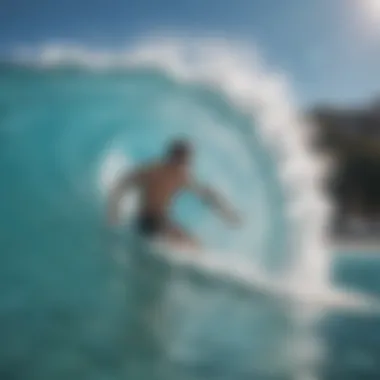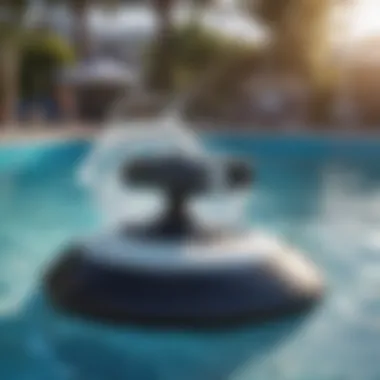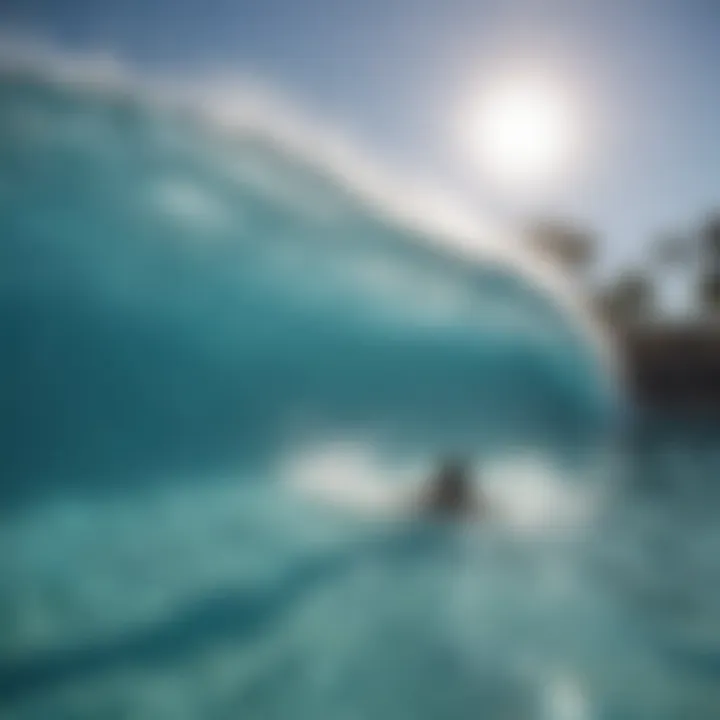Exploring Pool Wave Makers: Features and Benefits


Intro
As the warm sun casts its glow on the crystal-clear waters of a swimming pool, a new experience emerges beneath the surface: the rhythmic ebb and flow of artificial waves. Pool wave makers are swiftly becoming a favored addition for recreational enthusiasts. They enhance the swimming experience by simulating oceanic conditions right in your backyard. But what exactly goes into the creation of these delightful undulations, and why should anyone consider adding such equipment to their swimming pool?
In this guide, we will peel back the layers of functionality these devices offer, exploring their significance not just for aquatic play but also for enhancing fitness regimes.
Techniques and Skills
Fundamental Techniques for Beginners
Starting out with a pool wave maker might seem intimidating, but with a little guidance, most people can dive right in. Here are some foundational techniques to get you moving smoothly:
- Understanding Wave Dynamics: Begin by familiarizing yourself with how wave makers generate waves. They utilize a combination of water displacement and propulsion to create the desired wave effect. Whether it's using a pump or submersible motors, grasping these basics will help you appreciate the mechanics.
- Proper Positioning: It's crucial to find the right spot in the pool for the wave maker to function effectively. Usually, placing it at one end allows for optimal wave propagation.
- Testing Settings: Most pool wave makers come with adjustable settings. Before you open the floodgates, play around with the intensity and frequency of the waves. This experimentation can lead to a better understanding of what’s enjoyable for you and fellow swimmers.
Advanced Skills for Experienced Athletes
For athletes looking to capitalize on these engineered waves, mastering skills goes a step further. Here are some advanced techniques to elevate your training:
- Wave Riding Techniques: Advanced swimmers can practice techniques similar to those used in surfing. Learning how to balance on waves generated within your pool prepares you for larger ocean waves.
- Incorporating Fitness Regimens: Use waves as a tool for workouts. Think about drills where you swim against the waves, enhancing strength and endurance.
- Group Techniques: Coordinating with friends can lead to the creation of larger waves. Swimmers can form teams to create a more dynamic environment and work together to navigate challenges.
Safety and Gear
Essential Safety Measures in Watersports
Engaging with wave makers does come with responsibilities. To ensure safety while enjoying the waves:
- Make Use of Life Jackets: Especially for those inexperienced in deep water or swimming, having proper flotation devices can be a lifesaver.
- Supervision: Always swim with a buddy or have someone observing, particularly when testing wave makers for the first time.
- Know Your Limits: Understand the power and capability of your wave maker. It's not a kiddie pool—be mindful of wave heights and strength.
Gear Reviews and Recommendations
When it comes to selecting equipment for optimal performance, here are some standout choices:
- Aquaforce Wave Maker: Offers adjustable wave strengths and is known for its durability, making it a good choice for various pool sizes.
- SwimWave 3000: Renowned for its user-friendly interface, it's ideal for beginners as it simplifies wave settings.
- WaveTech Pro: A more advanced model for competitive training, featuring programmable options for specific training regimens.
"Utilizing wave makers can change the way we view swimming—transforming a simple dip into a vibrant, engaging experience." - Aquatic Technology Enthusiast
In the world of pools, wave makers stand as a testament to innovation in leisure and athleticism. This guide sheds light on the techniques, skills, and safety measures intrinsic to their use, providing the groundwork for a safe and thrilling aquatic adventure.
Prelude to Pool Wave Makers
Pool wave makers represent a fascinating intersection of engineering and leisure, transforming conventional swimming pools into dynamic aquatic environments. In today’s fast-paced world of water sports, these devices have gained significant traction among enthusiasts, facility owners, and trainers alike. By introducing waves, pool wave makers can enhance not just the aesthetic appeal of a swimming area, but also the functionality, making them invaluable tools in recreational and professional settings.
The importance of this technology cannot be overstated, as it caters to various needs—from casual fun to rigorous skill training. Families seeking excitement can enjoy splashing about in artificially generated waves, while athletes can hone their swimming techniques in controlled conditions. With a diverse range of applications and designs, understanding wave makers is essential for pool owners looking to offer unique experiences.
Definition of a Wave Maker
A wave maker is essentially a device designed to create artificial waves in a swimming pool setting. These machines work by moving water in a way that replicates the gentle laps or vigorous swells found in oceans and lakes. Unlike a simple water jet that might cause minor ripples, a properly designed wave maker can produce waves of variable sizes and intensities.
Depending on their construction and mechanics, wave makers can generate different types of wave patterns. Some models excel at producing consistent, smaller waves suitable for recreational play. On the other hand, advanced wave generating devices can create larger swells, akin to surfing conditions, catering to thrill-seekers.
Historical Development
The evolution of wave makers is a story as rich as the waves they produce. The concept of artificially generating waves began in the mid-20th century, when pool designers sought to mimic natural swimming conditions. Early attempts focused mostly on hydraulic systems that relied heavily on pumps and channels to deliver water flow.
As technology progressed through the decades, so too did wave-making devices. The introduction of pneumatic systems allowed for more innovative designs, capable of generating a wider variety of wave shapes and sizes. Fast forward to the modern era, and numerous companies have invested in research and development, resulting in sophisticated wave makers that use both hydraulic and mechanical principles to create realistic aquatic environments. This journey reflects not just technological advancements, but also a growing recognition of the role that artificial waves can play in enhancing water sports and recreational activities.
The combination of engineering prowess and innovative design has turned wave makers into essential features for modern pools, facilitating unparalleled aquatic fun.
As we continue to explore this topic, we will delve deeper into the science behind wave generation, types of wave makers available today, and the various applications that make these devices integral to both entertainment and training in aquatic environments.
The Science Behind Wave Generation
The science behind wave generation is fundamentally important to understanding the functioning of pool wave makers. Artificial wave pools have transformed recreational swimming into an exhilarating experience, mimicking the motion and rhythm of natural water bodies. This section will elaborate on how waves are created in pools, the essential hydrodynamic concepts involved, and the various types of waves produced, enhancing the overall swimming experience for enthusiasts and outdoor adventurers alike.
Mechanics of Wave Creation
Creating waves involves exerting energy onto the water's surface, initiating a series of movements that generate the fluid motion we associate with waves. Wave makers utilize several mechanical methods to achieve this. The mechanics can be broken down into three main components: movement, energy, and water displacement.
- Movement: This refers to the mechanism that translates energy into wave motion. For instance, mechanical systems may operate using paddles or motors that push the water, creating ripples.
- Energy: Energy conversion is crucial. Hydraulic systems apply pressure, while pneumatic systems use air pressure to produce waves. The efficiency of these energy systems largely determines the quality and size of the generated waves.
- Water Displacement: Displacing water creates a flowing motion; as the water moves, waves are formed. The shape and position of the wave maker can also dictate how the water displaces, impacting the resultant wave's nature.
Taking these components into account, wave makers can create different wave profiles tailored to specific activities such as surfing, swimming, or recreational riding.
Hydrodynamic Principles
Hydrodynamics plays a crucial role in understanding wave motion. The interaction of forces and how they cause movement within fluids provides key insights into wave dynamics. A few principles to consider include:
- Pressure and Gravity: The interplay between the pressure applied on the water and the gravitational pull creates wave phenomena. As water is displaced, the resulting force causes waves to propagate outward.
- Wave Energy: Energy is transmitted through wave motion. It can be described in terms of potential and kinetic energy as the wave travels, which is fundamental for designing effective wave generating technologies.
- Ideal Flow Conditions: Hydrodynamics also emphasizes the importance of maintaining consistent flow conditions. Factors such as wind, temperature, and pool shape can impact wave generation and quality, indicating that engineers must account for surroundings in design.
Understanding these principles ensures that pool designers can create tailored wave experiences that cater to various activities, making pools more appealing for their users.


Types of Waves Produced
Different types of waves can be generated depending on the mechanism and purpose of the wave maker:
- Small Ripples: Often used for leisurely swimming, these gentle waves provide a calm yet engaging environment. They can be soothing for recreational swimmers or children.
- Medium Waves: Suited for casual surfing or training. They provide an intermediate challenge for swimmers or surfers, making them a popular choice for fitness and skill development.
- Large Waves: These powerful waves create ideal conditions for surf training and competitions. They demand skill and experience, attracting advanced swimmers or professional surfers.
- Variable Waves: Many modern wave makers offer customizable options to alter wave size and frequency, catering to diverse preferences and skills in one pool setting.
"The evolution of wave technology allows a variety of activities within the same environment, appealing to all water enthusiasts."
In essence, grasping the science of wave generation provides clarity on how technology can enhance aquatic experiences. A proper understanding of mechanics, hydrodynamics, and wave types can not only assist pool owners in choosing appropriate wave makers but also deepen the appreciation for the complexity behind artificial waves.
Types of Pool Wave Makers
In the realm of creating artificial waves, understanding the different types of wave makers is key for any pool owner or enthusiast. Each type serves unique purposes, offering distinct benefits that can enhance the swimming experience. When selecting a wave maker, consider factors like the pool size, desired wave height, and specific use cases. This section will explore four primary types of pool wave makers, shedding light on their mechanisms and applications in aquatic environments.
Mechanical Wave Makers
Mechanical wave makers create waves through physical movement systems. These devices usually employ a pendulum-like mechanism or a series of gears that oscillate, which in turn pushes water and generates waves. Their design can range from simple paddles to complex rigs, depending on the pool requirements.
The most prominent advantage of mechanical wave makers is their effectiveness in generating consistent wave patterns. For recreational users, this means a smooth and steady experience. However, installation location is crucial; they need sufficient space and often require customization to fit various pool shapes. Additionally, while they can be robust, maintenance demands can be higher compared to other types, necessitating occasional checks on mechanical components for wear and tear.
Hydraulic Wave Makers
Hydraulic wave makers utilize water pressure to create waves. Water is pumped through a system that generates a series of currents, producing waves that can vary in size and intensity. These systems are often integrated with pool filtration systems, adding efficiency to the overall water management process.
One notable benefit of hydraulic wave makers is their adaptability to different pool configurations. Whether it's a large, sprawling commercial pool or a compact residential one, these wave makers can be tailored to suit specific dimensions and user needs. Moreover, since they rely on existing water systems, their installation might be simpler in scenarios where plumbing upgrades are limited. However, an initial investment can be substantial, so prospective buyers should weigh the long-term benefits against the upfront costs.
Pneumatic Wave Makers
Pneumatic wave makers work by using compressed air to generate waves. These systems release bursts of air beneath the water surface, creating a displacement that results in ripples and waves. This technology is particularly popular in wave pools designed for surfing and water sports, where a more controlled and powerful wave generation is essential.
The primary appeal of pneumatic systems lies in their ability to create dynamic, customizable wave profiles. Enthusiasts can adjust settings to replicate various wave conditions, from gentle swells to more challenging surf-like environments. However, they require access to a supply of compressed air, which can be a point of contention for some users. Efficiency of operation and the potential noise during operation are also considerations when evaluating this wave maker type.
Mobile Wave Generators
Mobile wave generators are essentially portable devices that can be moved around the pool or different locations. They allow for the creation of waves in various pool settings without needing a permanent installation. Commonly seen during events or competitions, these devices can vary in complexity from inflatable setups to sophisticated machines.
These generators provide flexibility, allowing for quickly changing wave conditions according to user demands. They are particularly advantageous for those who want to engage in water sports in different locations, or for temporary events requiring wave simulations. The downside? While practical, they can be less efficient in generating consistent waves as compared to fixed systems, and there may be practical limitations on how much they can affect water movement in larger pools.
"Each type of pool wave maker offers unique pros and cons, making it essential for potential buyers to understand their needs before making a decision."
In summary, the choice between mechanical, hydraulic, pneumatic, and mobile wave makers hinges on individual pool characteristics, desired wave outcomes, and usage scenarios. By understanding these differences, pool owners can make informed decisions that elevate their aquatic experiences, ensuring optimal enjoyment for all swimmers.
Applications of Wave Makers in Pools
The presence of wave makers in swimming pools has revolutionized the aquatic experience, turning ordinary pools into dynamic environments. Their significance stretches beyond mere aesthetics; they enhance recreational activities and introduce various practical applications that cater to a wide array of interests. These systems create an engaging atmosphere while serving essential functions that can greatly enrich water-based activities.
Recreational Swimming
When it comes to recreational swimming, wave makers provide an excitement that simply isn't found in static water environments. The introduction of waves can lead to a +fun thrill+ akin to the ocean experience, allowing swimmers to enjoy diverse aquatic activities without leaving the comfort of their neighborhood. Instead of just swimming laps back and forth, people can surf, swim against the current, or throw beach-like parties right at home. The addition of waves can cater to various swimming styles, making it suitable for all ages and skill levels.
Moreover, the waves can be tailored to different intensities. For the casual swimmer, gentle swells provide an easygoing atmosphere, whereas more daring enthusiasts can opt for higher energy waves. This adaptability makes wave makers appealing for public pools as well, attracting families and groups eager for a unique aquatic adventure.
Training and Skill Development
Beyond recreation, wave makers play a crucial role in training environments. They provide athletes with an opportunity to practice under conditions that simulate those of larger bodies of water. The addition of waves allows triathletes, surfers, and swimmers to refine their skills and techniques, preparing them for competition.
One notable aspect is how athletes can practice maintaining stability and balance in moving water. This training is particularly vital for segments like surfing or even for swimmers looking to enhance their performance in open-water races. Not only do these wave makers enhance the training experience, but they also foster a competitive spirit among trainees, pushing them beyond their limits.
Therapeutic Benefits
There is more to wave makers than just recreation and training; they also significantly impact health and therapy. Various aquatic therapeutic programs incorporate wave-making technology to provide soothing yet invigorating experiences. The rhythmic motion of waves can help promote relaxation, reduce stress, and even facilitate physical rehabilitation.
In therapy settings, the waves can assist with muscle relaxation and coordination, making them a vital tool in physiotherapy. Moreover, mixed with other treatments, the soothing motion can enhance circulation, improving overall health. According to various studies, aquatic therapy has shown positive outcomes for individuals with joint pain, arthritis, and even neurological conditions. The therapeutic aspect of wave makers truly underscores their multifaceted benefits.
Event Hosting
Wave makers bring a unique dimension to event hosting as well. They transform swimming pools into vibrant venues for parties, sporting events, or even competitions. Imagine hosting a beach-themed party complete with waves crashing against the side of the pool, where guests can surf or play water games.
Such amenities not only enhance the fun but also make the venue more attractive for diverse activities, from water polo matches to synchronized swimming displays. As more people seek ways to make celebrations unique, the role of wave makers in event hosting becomes increasingly significant.
In summary, the applications of wave makers extend far beyond simple aesthetics; they contribute to recreational swimming, serious training, therapeutic needs, and memorable events, making them an invaluable addition to modern aquatic facilities.
"Wave makers not only replicate the ocean's thrill but also enrich every layer of aquatic enjoyment and functionality".
By using these systems, pool owners can cultivate a more engaging, versatile, and enjoyable experience for all who wish to take the plunge.
Choosing the Right Wave Maker for Your Pool
Selecting the appropriate wave maker for your pool is a critical step that can significantly boost the swimming experience. A good choice not only creates enjoyable waves but also considers factors like pool size, wave characteristics, and budget. With various options available on the market, understanding the nuances of each aspect can help you make an informed decision.
Assessing Pool Size and Shape


The dimensions and design of your pool play a fundamental role in determining the type of wave maker that will be suitable. A small, rectangular pool might not support the same equipment as a larger, more irregularly shaped pool. Each wave maker has a specified range of effectiveness, so it's essential to check those details first.
- Small Pools: In a cozy setup, think about a mechanical wave maker designed for limited space. These units are less powerful but can still create a satisfying wave without overwhelming the area.
- Large Pools: Conversely, for expansive or custom-shaped pools, hydraulic or pneumatic systems may deliver the significant wave action you seek. These machines can adjust wave sizes that adapt better to varying pool geometries.
Keep in mind, certain shapes, like L-shaped pools, may require specialized wave makers. You wouldn’t want a system that creates chaotic waves in an area intended for relaxation.
Evaluating Wave Height and Frequency
When considering a wave maker, one must closely evaluate the desired wave height and frequency. These parameters affect how the water interacts with swimmers.
Different activities benefit from different wave patterns. For example:
- Low Waves (1 to 2 feet): Perfect for casual swimming and relaxation. Ideal for children and adults alike who want a gentle experience.
- Moderate Waves (2 to 4 feet): Suitable for more active forms of swimming, like training or recreational surfing.
- High Waves (4 feet and above): For thrill-seekers, this level engages more advanced skill sets and safety precautions.
Understanding the frequency of wave production also matters. A consistent short interval between waves can enhance the surfing experience, but too many waves too quickly can create chaos, making it hard to enjoy a leisurely swim. Find a balance that suits your intended use.
Cost Considerations
Finally, the financial aspect cannot be dismissed. But before jumping into numbers, consider the long-term investment you’re making. While some wave makers may have a lower purchase price, they might incur significant operating costs down the line.
Here are factors to contemplate:
- Initial Investment: Price for the wave maker itself can vary widely. Mechanical models tend to be more affordable, whereas hydraulic units could be pricier due to complexity.
- Installation Expenses: Don’t overlook installation costs. Professional assistance might save you headaches later, especially with complicated setups.
- Operational Costs: These include electricity, maintenance, and water usage. Some systems are designed to be energy-efficient, potentially leading to savings over time.
- Potential Upgrades: As technology progresses, you might find a model suited to your needs better later on. Consider how easy it is to upgrade your model or integrate with new technologies.
By carefully assessing these criteria, you put yourself in a much better position for selecting the right wave maker, ensuring that your pool becomes the go-to spot for fun and fitness alike.
Installation of Pool Wave Makers
The installation of pool wave makers is a pivotal aspect that can greatly influence the performance and enjoyment of your swimming experience. Understanding the intricacies involved can lead to a smoother integration and a functional addition to your pool setup. The right installation ensures optimal wave creation, enhances water circulation, and ultimately contributes to a more enjoyable swimming environment.
Professional Installation vs. DIY
When it comes to installing wave makers, there's a perennial debate between hiring professionals versus taking the DIY approach. Each has its own merits.
Professional Installation
- Often entails expert knowledge, ensuring that the wave maker is correctly calibrated for the specific pool dimensions and intended use.
- Saves time, as professionals usually have the tools and experience to complete the installation efficiently.
- May come with warranties or guarantees, providing peace of mind in case of discrepancies.
DIY Installation
- Can be a cost-effective option if you're handy and familiar with pool systems.
- Allows you to engage in the process personally, which can be quite rewarding.
- However, it might come with risks if you're not well-versed in the nuances of plumbing or electrical installations.
Experimentation during DIY can yield valuable insights, but it’s essential to weigh the risks involved against the potential savings. If you're mechanically inclined, starting this project yourself might be worth considering.
Preparation of the Site
Successful installation hinges heavily on thorough site preparation. Key elements come into play here. Firstly, the site must be cleared of any debris or obstacles. This includes rocks, plants, or anything that could hinder access to the installation area.
Next, assessing water depth is vital; it helps in deciding where to place the wave maker for optimal performance. Contour and stability of the pool's flooring are also crucial. If the ground is uneven, not preparing it properly could lead to inefficient wave generation.
Additional aspects to prepare include:
- Access to electricity for power-supplied wave makers.
- Plumbing adjustments if integrating with existing systems.
- Marking boundaries for where the wave maker will be installed. This clarity helps streamline the installation process while ensuring you make full use of the wave-generating capability.
Integration with Existing Pool Systems
When incorporating a wave maker, seamless integration with your current pool setup is fundamental. Often, wave makers require connections to various systems like filtration and circulation. Understanding how your existing components work together can avoid conflicts and ensure functionality.
- Assess Compatibility: First, check if the wave maker’s specifications align with your current pool system, especially regarding power and water flow.
- Adjust Filtration Systems: Wave makers can introduce additional water circulation, which may require upgrading your filtration systems to handle the new demand.
- Monitor Water Chemistry: The introduction of waves can distribute chemicals differently, hence regular testing is recommended post-installation.
Proper integration can elevate your swimming pool experience significantly, creating not just waves but a harmonious aquatic environment.
Ultimately, solid preparation and execution are the bedrock of successful pool wave maker installation. Armed with this understanding, pool owners can make informed choices that enhance their aquatic leisure pursuits.
Maintenance and Care for Wave Makers
Proper maintenance and care for wave makers is crucial to ensure their long-term functionality and optimal performance. Just like a well-oiled machine, these devices require regular attention to maximize their efficiency in generating those desired waves for a thrilling swimming experience. Keeping wave makers in prime condition not only enhances the enjoyment for users but also prolongs the life of the device itself. Regular maintenance can prevent a host of issues from surfacing, ultimately saving time and costs associated with more significant repairs down the line.
Routine Maintenance Practices
Establishing a routine maintenance schedule for wave makers can seem daunting at first, but it’s not as tricky as it may sound. Here are essential practices to keep in mind:
- Weekly Visual Inspections: Checking for any visible wear and tear on the wave maker's components should be habitual. Look for loose bolts, corroded parts, or any debris that could interfere with the performance.
- Clean Filters Regularly: Filters can get clogged up with pool debris, keeping the waves from flowing smoothly. Make it a point to clean these filters depending on usage; if the pool sees a lot of action on weekends, cleaning them every week may be prudent.
- Check Water Levels: Proper water levels can impact wave generation. Too low, and the wave maker won’t function efficiently; too high, and you may face overflow issues. Monitor levels consistently.
- Lubricate Moving Parts: If applicable, lubrication keeps moving parts from wearing prematurely. Use a silicone-based lubricant for hydraulic wave makers, ensuring that mechanisms run smoothly.
- Regular Electrical Checks: For electric wave makers, it’s vital to routinely inspect wiring and motor connections to avoid shorts or failures. Pay attention to any unusual sounds when the machine operates.
By keeping this routine, issues can often be spotted early, ultimately saving on costly repairs and replacements.
Troubleshooting Common Issues
Even with diligent maintenance, problems can occasionally arise with wave makers. Here’s a look at common issues and their potential solutions:


- No Waves Produced: If the wave maker is running but no waves are generated, check for obstructions in the water path or malfunctioning pumps. If the pump is broken, you may need to consult the manual for specific replacement instructions.
- Inconsistent Wave Height: Variations in wave height can stem from inconsistencies in water flow. Run a check on filter cleanliness and pump pressure. Adjusting the settings on your wave maker might also help standardize the waves.
- Strange Noises Coming from Wave Maker: Unusual sounds often signal that something isn’t right. It could be as simple as a loose bolt or as serious as a mechanical failure. Inspect all connections and parts and consult the user manual if necessary.
- Power Issues: If the wave maker isn’t turning on, firstly check the power supply. If everything appears in order but it still doesn’t work, you might be dealing with an internal electrical failure that might warrant a professional evaluation.
By keeping these troubleshooting steps in mind, many issues can be resolved promptly without needing advanced technical skills.
Impact of Wave Makers on Water Quality
The role of wave makers in swimming pools extends far beyond creating a fun environment for splashing around. Understanding their impact on water quality is vital for pool owners who wish to maintain a healthy aquatic environment. Proper circulation and filtration are not just technical details; they are essential components that directly affect both the clarity and cleanliness of the water. This section delves into the significance of wave makers in enhancing water quality, offering insights to outdoor enthusiasts who value a pristine swimming experience.
Circulation and Filtration Benefits
When not well-circulated, water tends to stagnate, accumulating debris, chemicals, and microorganisms. This is where wave makers can shine. They generate currents that effectively help to circulate the water throughout the pool. Circulation is crucial not just for aesthetics but also for health reasons. Here’s how wave makers contribute positively:
- Enhanced Water Movement: By simulating the natural motions of water, wave makers keep the water moving, preventing dead zones where debris might settle.
- Improved Filtration: As waves travel across the surface, they push water towards the skimmers and filters. This means that unwanted particles can be captured more effectively.
- Temperature Uniformity: Movement assists in distributing heat evenly throughout the pool, preventing cold spots and ensuring swimmers have a consistent experience.
"A well-circulated pool is the heart of a healthy swimming environment, transforming murky water into a crystal-clear oasis."
Effects on Chemical Balancing
Maintaining the right chemical balance in pool water is fundamental to ensuring a safe and pleasant swimming experience. Wave makers also play a crucial role in this aspect by contributing to better distribution of chemicals throughout the pool:
- Even Distribution of Chemicals: When chemicals are added, they can take time to disperse evenly. The motion from wave makers helps to distribute chlorine, pH balancers, and sanitizers more quickly and uniformly, cutting down on the time needed for these chemicals to take effect.
- Prevention of Chemical Concentration: By mixing water and chemicals, wave makers help to prevent areas of high concentration, which can lead to irritation for swimmers and algae growth.
- Enhanced Oxygen Levels: The movement of water increases oxygen dissolution rates, which can be beneficial for maintaining water quality and supporting any life forms within the pool, including beneficial bacteria.
Environmental Considerations
In the conversation about pool wave makers, we can't skip over environmental considerations. These devices, while enhancing our recreational experiences, also bring their own set of implications for the environment. The urgency to be mindful of these aspects is on the rise, especially as technology increasingly intertwines with daily life. When we discuss wave makers, we're not just talking about creating fun waves for swimming; we also need to think about how these systems interact with our ecological system.
Sustainability of Wave Generation Technology
Sustainability in wave generation technology revolves around the materials, processes, and methods employed in the design and production of these devices. Newer models of wave makers often prioritize reduced environmental impact through the use of recyclable materials and eco-friendly designs. For example, manufacturers are developing wave makers made from recycled plastics or using natural materials that won't pollute water when worn down over time.
Moreover, the design also plays a crucial role in sustainability. Some wave makers are now engineered to minimize energy use without compromising performance. This means they create waves effectively while consuming less power, thus leaving a smaller carbon footprint. It's a win-win situation: pool owners get to enjoy thrilling aquatic experiences, and the planet breathes a little easier.
Energy Efficiency Measures
Energy efficiency is a significant focal point in modern wave maker technology. Pool owners are increasingly concerned about energy consumption, not just for cost reasons, but also for the environmental implications. Here are some energy efficiency measures that have become standard practice:
- Inverter Technology: Some wave makers now come equipped with inverter technology which adjusts the motor speed based on real-time wave demands. This reduces unnecessary power consumption during low-demand periods.
- Smart Control Systems: Sophisticated control systems are becoming common, allowing users to customize wave settings. This ensures waves are only generated when needed, directly minimizing energy usage.
- Regular Maintenance: Regular maintenance of wave makers optimizes their efficiency. A well-maintained device runs smoother and consumes less power, which benefits both the environment and the user's wallet.
"Mindful design and energy considerations in wave makers pave the way for a more sustainable aquatic experience for everyone."
Ultimately, engaging with environmentally friendly practices and innovative designs, pool wave makers can significantly contribute to greener recreational swimming. It's about finding a balance between excitement and responsibility, paving the way for a future where fun doesn't come at the cost of our planet.
Future Trends in Wave Maker Technology
As the world of aquatic sports and recreation continues to evolve, so does the technology behind pool wave makers. Understanding these impending trends is critical for owners looking to upgrade or innovate their swimming experiences, ensuring they stay at the forefront of aquatic leisure. Today's designs are not merely about aesthetics; they incorporate advanced engineering that aims to enhance user experience, efficiency, and environmental sustainability. The future of wave makers is brimming with inventive ideas aimed at improving functionality while minimizing energy consumption.
Innovations in Design
Wave makers are undergoing a renaissance in their design. Manufacturers are increasingly adopting state-of-the-art materials like high-density polyethylene and lightweight composites which not only improve durability but also the overall efficiency of wave generation. This shift has opened doors for more compact and visually appealing models that can easily fit into various pool designs without compromising the essence of a swimming space.
The integration of fluid dynamics modeling has further enabled designers to optimize pump configurations, leading to more consistent wave patterns. These innovations do not stop at hardware; software advancements are also taking center stage. Today's wave makers can be programmed to create a variety of wave types—gentle ripples for relaxation or harsher waves for the more adventurous.
- Modular Designs: More wave makers will adopt modular designs, allowing pool owners to customize their systems based on activity needs or user experience preferences.
- User-Friendly Interfaces: Touchscreen controls and smartphone applications are becoming more common for easier management of wave settings.
Integration with Smart Pool Systems
As homes become increasingly connected, pool technology is following suit. The integration of wave makers with smart pool systems brings about a plethora of advantages. This smart connectivity enables pool owners to customize their aquatic environment with remarkable precision. Imagine being able to adjust wave intensity or switch wave types from your smartphone while lounging by the pool.
Integrating wave makers into smart systems can improve energy efficiency dramatically. For instance, these systems can operate only during peak hours to take advantage of lower energy rates or can synchronize with solar panels to reduce operational costs.
Moreover, data analytics can track usage patterns, giving owners insights into the most popular times for waves and the types of waves preferred by users, enhancing not only the pool experience but the entire maintenance and operations strategy.
In a world rapidly advancing towards interconnected systems, the flexibility and ease of use offered by smart wave makers is set to redefine recreational swimming.
The future is not just about improving technology but also about making it more user-centric. As wave makers become staples in modern pools, their evolving technology promises to enrich and redefine leisure time in profound ways, offering something for everyone whether it’s relaxation on a lazy afternoon or thrills for the more adventurous souls.
End
Wrapping up this exploration of pool wave makers, there’s no denying their place at the heart of modern aquatic fun. These devices transform ordinary pools into exciting realms of wave-driven activity, catering to both recreational and competitive needs. Wave makers are not just about creating waves; they enhance the overall swimming experience by integrating unique features that engage swimmers of various abilities.
A key takeaway is how these systems can influence water dynamics within a pool. The benefits of employing a wave maker extend far beyond the obvious thrill of surfing on simulated waves. They contribute to improved water circulation, which is essential for maintaining clean and safe swimming conditions. By ensuring that water is consistently moving, these devices help prevent stagnation, reducing chemical concentrations and promoting a healthier aquatic environment.
Furthermore, investing in a wave maker provides ample considerations for future use. Pool owners should deliberate on factors such as the pool size, intended use, and integration with existing systems. Proper alignment between a wave maker’s features and the needs of the pool can save headaches down the line. That’s not to mention the community benefits—pool wave makers can turn a backyard pool into a social hub, attracting families and friends, and rekindling a love for water sports.
In essence, as homeowners and aquatic enthusiasts weigh their options, understanding the significance of wave makers is crucial. They’re not merely tools for fun but vital components of an intricate water ecosystem.
Summarizing Key Takeaways
- Pool wave makers are essential for enhancing swimming experiences.
- They improve water circulation and maintain chemical balance in the pool.
- Proper consideration of pool characteristics is necessary for optimal operation.
- The social aspect of using wave makers creates a lively atmosphere around leisure.
Future Outlook for Pool Wave Makers
Looking ahead, the future of wave makers seems bright and promising. With advancements in technology, the design of these systems is likely to evolve significantly. Innovations could lead to more efficient and eco-friendly mechanisms that operate with less energy consumption, which every environmentally-conscious user will appreciate.
Moreover, the integration of smart technology into pool systems is on the rise. Imagine controlling wave settings with just a tap on your smartphone or syncing the wave maker with poolside lighting and sound systems for a comprehensive, multi-sensory experience. As wave makers become smarter and more user-friendly, they’ll not only ensure fun but also cater to a greater range of user preferences.
Finally, there’s potential for broader applications of wave makers in settings beyond traditional family pools. Water parks, training facilities, and resorts may usher in new designs tailored specifically for them, promoting diversity in aquatic operations while keeping in mind safety and efficiency. Thus, the realm of wave makers is undoubtedly evolving, promising a future where human-creativity meets water dynamics in unprecedented ways.















